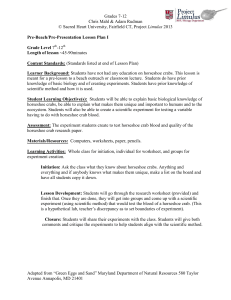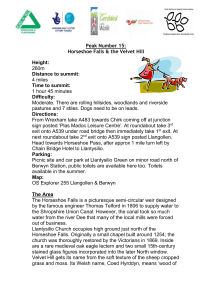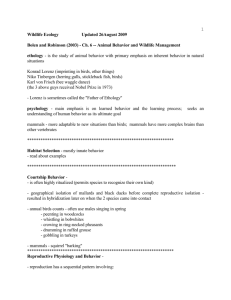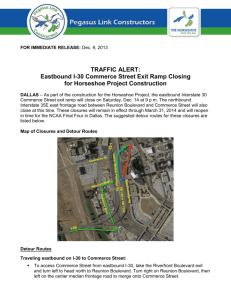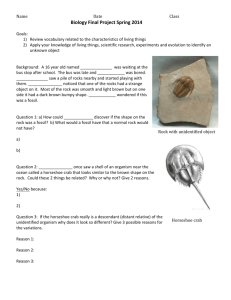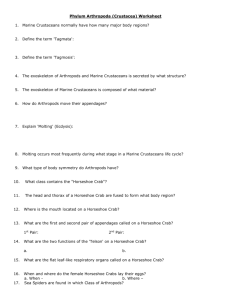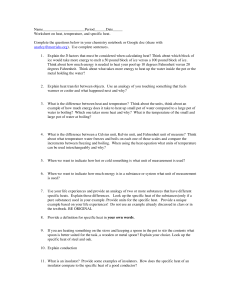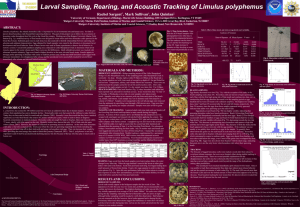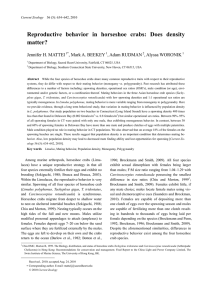The Horseshoe Crab
advertisement
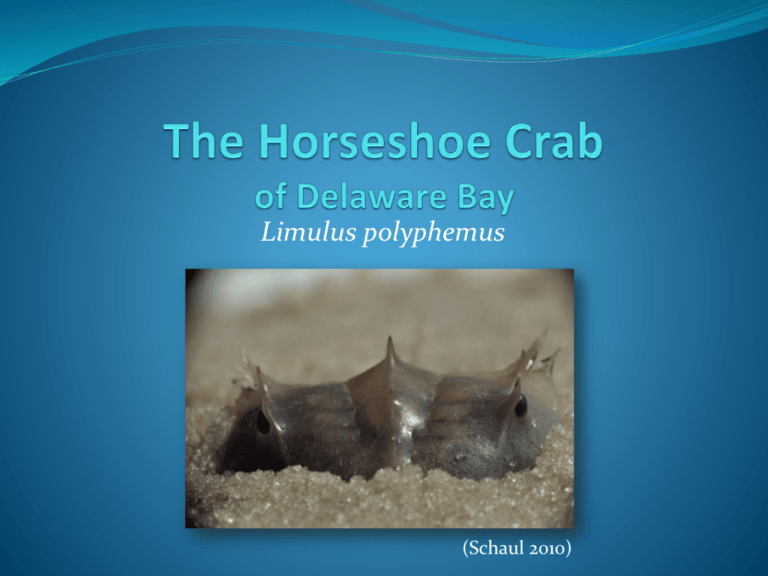
Limulus polyphemus (Schaul 2010) Outline Horseshoe Crab Overview Background Physical features Reproduction Nest Sites Life cycle Endangered? Why care? Important ecologically for migratory birds Production of LAL Bait for commercial harvesting of whelk and eel Future Research? Background Phylum Arthropoda Dates from Cambrian period Habitat (Chernoff 2011) shallow water along North American Atlantic coast Swims with abdominal plates Walks with walking legs Feed at night – worms & small mollusks Physical Features Dorsal View Ventral View (Skytitles 2010) (CCCMKC 2005) Reproduction Needed: High tide Spring/summer season Sexually mature female and male(s) (Query 2008) Process: Female buries eggs into sand External fertilization Reproduction: Who’s the Daddy? (Brockmann et al. 1994) Low Tide (ERDG 2009) Nest Sites Location, location, location! Just above mean high tide line Sandy beaches Sloped beaches (ERDG 2009) Nest Sites- Slope Study (Botton & Loveland 1987) Sloped beaches vs. Flat beaches Similar beaches, except degree of slope 4,300 total stranded horseshoe crabs 20-25% of stranded from sloped beach Blinded/Partially blinded HsC Similar data Nest Sites- Distance up beach (Penn & Brockmann 1994) (Penn & Brockmann 1994) Nest Sites- Tide Depth/Time (Penn & Brockmann 1994) Life Cycle (Penn & Brockman 1994) Egg 2 to 4 weeks Trilobite larvae 2 weeks Juvenile up to 10 years Adult 19 year life span average (ERDG 2009) (Query 2008) Endangered? Population numbers decreasing Natural threats Maturation duration Dangers during mating Egg/larval mortality Harvesting Biomedical research & companies Scientific research Bait for fisheries Why Care? Important ecologically for migratory birds Production of LAL Bait for commercial harvesting of whelk and eel $ Economy $ (Rizzardi 2009) (Breese 2009) (Karpanty et al. 2006) Limulus Amoebocyte Lysate (LAL) (Blackfang 2011) (Charles River Laboratories2011) Further Research Population structure Sex structure Limited studies Confined to Delaware Bay Most research on spawning populations (Volz 2008) Literature Cited Botton, M. L. & R. E. Loveland. 1987. Orientation of the horseshoe crab, Limulus Polyphemus, on a sandy beach. Biological Bulletin 173(2):289-298. Brockmann, H.J. 1990. Mating behavior of horseshoe crabs, Limulus polyphemus. Behaviour 114(1/4):206-220. Brockmann, H.J., T. Colson, W. Potts. 1994. Sperm competition in horseshoe crabs (Limulus polyphemus). Behavioral Ecology and Sociobiology 35(3):153-160. Coursey, Y., N. Ahmad, B.M. McGee, N. Steimel, M. Kimble. 2003. Amebocyte production begins at stage 18 during embryogenesis in Limulus polyphemus. Biological Bulletin 204(1):21-27. DNR. 2005. Horseshoe crabs: a living fossil. Maryland Departments of Natural Resources. Available: http://www.dnr.state.md.us/education/horseshoecrab/. (June 2011). Hickman, C.P., L.S. Roberts, S.L. Keen, A. Larson, D.J. Eisenhour. 2007. Animal diversity, 4th Edition. McGraw Hill, Boston. Karpanty, S. M., J.D. Fraser, J. Berkson, L. J. Niles, A. Dey, E.P. Smith. 2006. Horseshoe crab eggs determine red knot distribution in Delaware Bay. The Journal of Wildlife Management 70(6):1704-1710. Penn, D. & H.J. Brockmann. 1994. Nest-site selection in the horseshoe crab, Limulus polyphemus. Biological Bulletin 187(3):373-384. Rizzardi, K. 2009. With red knots on the candidate list, third circuit declares emergency listing dispute moot. ESA BLAWG. Available: http://www.esablawg.com/esalaw/ESBlawg.nsf/d6plinks/KRII-7QA2EU. (June 2011). Rutecki, D., R.H. Carmichael, I. Valiela. 2004. Magnitude of harvest of Atlantic horseshoe crabs, Limulus polyphemus, in Pleasant Bay, Massachusetts. Estuaries 27(2):179-187. Sekiguchi, K., H. Seshimo, H. Sugita. 1988. Post-embryonic development of the horseshoe crab. Biological Bulletin 174(3):337-345 Smith, D.R., P.S. Pooler, R.E. Loveland, M.L. Botton, S.F. Michels, R.G. Weber, D.B. Carter. 2002. Horseshoe crab (Limulus polyphemus) reproductive activity on Delaware Bay beaches: interactions with beach characteristics. Graphics Cited Blackfang. 2011. Horseshoe Crab blood = $15,000. NG BBS. Available: http://www.newgrounds.com/bbs/topic/1251364/1. (June 2011). Breese, G. 2009. Red Knot feeding on eggs of Horseshoe crabs. Wikipedia. Available: http://en.wikipedia.org/wiki/File:Red_knot_horseshoe_crab_feeding.jpg. (June 2011). CCCMKC. 2005. Horseshoe crab menu. Available: http://cccmkc.edu.hk/~keikph/Fossil/Horseshoe%20crab%20menu.htm. (June 2011). Charles River Laboratories. 2011. Horseshoe crab (Limulus polyphemus) facts and figures. Available: http://info.criver.com/endotoxin_and_rapid_microbiological_products/horseshoecrab1. html. (June 2011). Chernoff, D. 2011. Shoreline. Available: http://www.dcwild.com/index.htm. (May 2011). ERDG. 2009. The Horseshoe Crab. Ecological Research & Developmental Group. Available: http://www.horseshoecrab.org/nh/life.html. (May 2011) Greer, S. 2007. Horseshoe crabs. Smithsonian National Museum of Natural History. Available: http://www.mnh.si.edu/exhibits/natures_best_2006/gallery/horseshoecrabs.html. (June 2011). Photos Cited Rizzardi, K. 2009. With red knots on the candidate list, third circuit declares emergency listing dispute moot. ESA BLAWG. Available: http://www.esablawg.com/esalaw/ESBlawg.nsf/d6plinks/KRII-7QA2EU. (June 2011). Schaul, J. 2010. Horseshoe crabs need compassion and help to survive. National Geographic News Watch. Available: http://newswatch.nationalgeographic.com/2010/11/04/horshoe_crabs_need_co mpassion/. (May 2011). Skytitles. 2010. What types of hermit crabs should be placed in a saltwater aquariums? Zimbio. Available: http://www.zimbio.com/Pets+and+More+Pets/articles/r3J16YIXqzR/Types+He rmit+Crabs+Placed+Saltwater+Aquariums. (June 2011) Query, S. 2008. Crash: a tale of two species. Audobon. Available: http://www.audubonmagazine.org/webexclusives/twospecieswebExclusives.html. (June 2011) Volz, M. 2008. Limulus polyphemus: Atlantic Horseshoe Crab-Habitat. UWLax Organismal Biology. Available: http://bioweb.uwlax.edu/bio203/2011/volz_mack/contact.htm. (June 2011). Questions???? (Greer 2007)
